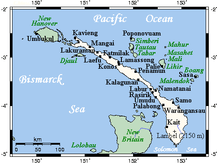New Ireland (island)
| Native name: <span class="nickname" ">Niu Ailan | |
|---|---|
 New Ireland's main towns and nearby islands | |
 New Ireland (island) | |
| Geography | |
| Coordinates | 3°20′S 152°00′E / 3.33°S 152°E |
| Archipelago | Bismarck Archipelago |
| Area | 7,404 km2 (2,859 sq mi) |
| Length | 360 km (224 mi) |
| Width | 10 km (6 mi) - 40 km (25 mi) |
| Highest elevation | 2,379 m (7,805 ft) |
| Highest point | Mount Taron |
| Country | |
|
Papua New Guinea | |
| Province | New Ireland Province |
| Largest settlement | Kavieng (pop. 10,600) |
| Demographics | |
| Population | 118,350[1] (as of 2002) |
New Ireland (Tok Pisin: Niu Ailan) is a large island in Papua New Guinea, approximately 7,404 km² in area with ca. 120,000 people.[2] It is the largest island of the New Ireland Province, lying northeast of the island of New Britain. Both islands are part of the Bismarck Archipelago, named after Otto von Bismarck, and they are separated by Saint George's Channel. The administrative centre of the island and of New Ireland province is the town of Kavieng located at the northern end of the island. While the island was part of German New Guinea, it was named Neumecklenburg ("New Mecklenburg").
Geography

The island is part of the Bismarck Archipelago and is often described as having the shape of a musket. For much of its 360 kilometers in length, the island's width varies between less than 10 km to 40 km, yet the central mountainous spine is very steep and rugged. The highest peak is Mount Taron in the Hans Meyer Range (2,379 meters). Other mountain ranges are Tirpitz, Schleinitz, Verron and Rossel.[3] The island lies between two and five degrees south of the equator. The original land cover was primarily dense rainforest.
New Ireland is surrounded by the Bismarck Sea in the southwest and by the Pacific Ocean in the northeast.
History
The first inhabitants of the Bismarck Archipelago arrived around 33,000 years ago after sailing from what is now Papua New Guinea. Later arrivals included the Lapita people approximately 3,000 years ago. Three distinct cultural practices are characteristic of the native people of New Ireland: Kabai, Malagan and Tumbuan.[4]
In 1616 the Dutch sailors Jacob Le Maire and Willem Schouten were the first Europeans to set foot on the island.
In the 1870s and 1880s, the Marquis de Rays, a French nobleman, attempted to establish a French colony on the island called New France.[5] He sent four ill-fated expeditions to the island, the most famous of which caused the death of 123 settlers.
From 1885 to 1914 New Ireland was a part of German New Guinea and bore the name Neumecklenburg. Germans managed several highly profitable copra plantations and built a road to transport the goods. This road is currently in service and is named the Boluminski Highway after the German administrator of German New Guinea, Franz Boluminski. After World War I New Ireland was ceded to Australia. Australia renamed the island New Ireland, after the island of Ireland. In January 1942, during World War II, the island was captured by Japanese forces and was under their control.
Ecology
Widespread deforestation and degradation of lowland rainforest is an issue on New Ireland and the other eastern islands of Papua New Guinea (New Britain, Bougainville Island) as well as on Papua New Guinea mainland. Nearly 60 percent of their forests are accessible to logging, and by 2002, 63 percent of the accessible forests had been deforested or degraded.[6]
Culture
- Malagan - funerary arts that originate in Tabar Group, and have been imported to the northern region of New Ireland.[7]
- Tatanua - "The person who organises a tatanua performance must select the music and dancers, assemble a male chorus and acquire the masks. The masks are usually rented from one of the sculptors who makes them."[8]
- Kulap - chalk limestone funerary sculptures [9]
References
- ↑ "New Ireland Province" (PDF). Retrieved 2014-08-16.
- ↑ United Nations Environment Program, "Islands by land area: New Ireland," islands.unep.ch (1988).
- ↑
- ↑ "People & Culture". New Ireland Tourism. Retrieved 2014-08-16.
- ↑ Cahoon, Ben (2000). "Papua New Guinea". Worldttatesmen.org.
- ↑ http://visibleearth.nasa.gov/view.php?id=8842
- ↑ Gunn, Michael; Phillipe Feltier (2006). New Ireland: Art of the South Pacific. Milan: Continents Editions. ISBN 88-7439-369-5.
- ↑ d'Alleva, Anne (1998). Kara Hattersley-Smith, ed. Arts of the Pacific Islands. New York: Perspectives - Harry N. Abrams, Inc., Publishers. p. 75. ISBN 0-8109-2722-5.
- ↑ "Male Figure (Kulap) [Southern New Ireland] (1981.331.5) | Heilbrunn Timeline of Art History | The Metropolitan Museum of Art". Metmuseum.org. 2014-06-02. Retrieved 2014-08-16.
External links
| Wikimedia Commons has media related to New Ireland. |
| Wikisource has the text of the 1921 Collier's Encyclopedia article New Ireland. |
- Entry at the Linköping University
- "New Britain-New Ireland lowland rain forests". Terrestrial Ecoregions. World Wildlife Fund.
- Persée : Archaeological survey in southern New Ireland
- Wallaby extinctions at the Macropodid frontier
Coordinates: 3°20′S 152°00′E / 3.33°S 152°E